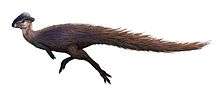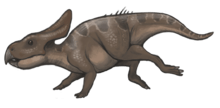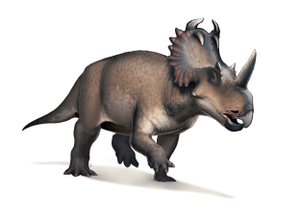Chasmosaurinae
Chasmosaurinae is a subfamily of ceratopsid dinosaurs. They were one of the most successful groups of herbivores of their time. Chasmosaurines appeared in the early Campanian, and became extinct, along with all other non-avian dinosaurs, during the Cretaceous–Paleogene extinction event. Broadly, the most distinguishing features of chasmosaurines are prominent brow horns and long frills lacking long spines; centrosaurines generally had short brow horns and relatively shorter frills, and often had long spines projecting from their frills.
| Chasmosaurines | |
|---|---|
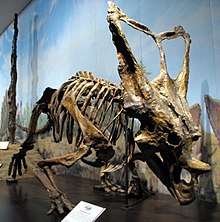 | |
| Chasmosaurus belli skeleton, Royal Tyrrell Museum of Palaeontology | |
| Scientific classification | |
| Kingdom: | Animalia |
| Phylum: | Chordata |
| Clade: | Dinosauria |
| Order: | †Ornithischia |
| Family: | †Ceratopsidae |
| Subfamily: | †Chasmosaurinae Lambe, 1915 |
| Type species | |
| †Chasmosaurus belli Lambe, 1902 | |
| Subgroups | |
| Synonyms | |
| |
Chasmosaurines evolved in western North America (Laramidia). They are currently known definitively from rocks in western Canada, the western United States, and northern Mexico. They were highly diverse and among the most species-rich groups of dinosaurs, with new species frequently described. This high diversity of named species is likely a result of the frill. The distinctive shape of the frill the hornlets on its edges (epoccipitals) make it possible to recognize species from incomplete or fragmentary remains.
Classification
Below is the phylogeny of Caleb Brown and Donald Henderson (2015):[1]
| Chasmosaurinae |
| ||||||||||||||||||||||||||||||||||||||||||||||||||||||||||||||||||||||||||||||||||||||||||||||||||||||||||||||||||||||||
Below is the result of a phylogenetic analysis by Mallon et al., following the traditional epiparietal homology scheme from their description of Spiclypeus shipporum. Bravoceratops and Eotriceratops were removed because it was found that they decrease resolution in their analysis because of the authors' new interpretation of epiparietal configurations. Regaliceratops was not resolved as a member of the Triceratopsini.[2]
| Chasmosaurinae |
| |||||||||||||||||||||||||||||||||||||||||||||||||||||||||||||||||||||||||||||||||||||||||||||||||||||||||
Timeline
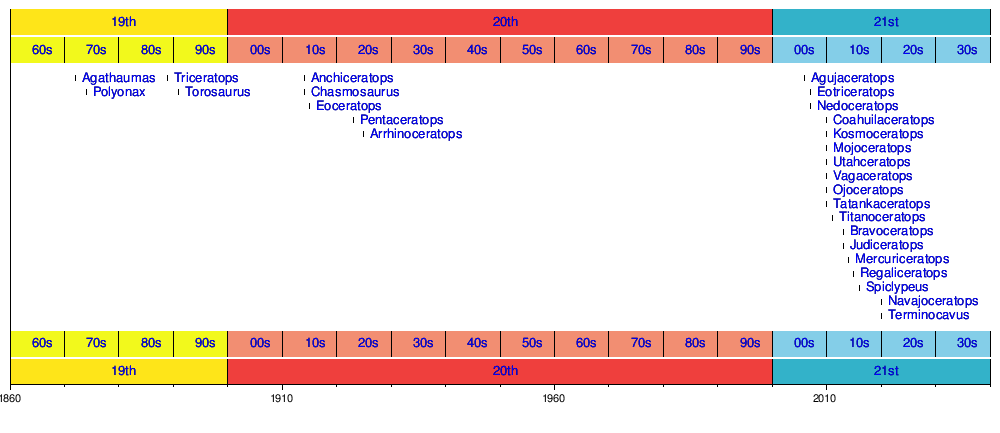
See also
References
- Brown, Caleb M.; Henderson, Donald M. (June 4, 2015). "A new horned dinosaur reveals convergent evolution in cranial ornamentation in ceratopsidae". Current Biology. 25 (online): 1641–8. doi:10.1016/j.cub.2015.04.041. PMID 26051892.
- Jordan C. Mallon, Christopher J. Ott, Peter L. Larson, Edward M. Iuliano and David C. Evans (2016). "Spiclypeus shipporum gen. et sp. nov., a Boldly Audacious New Chasmosaurine Ceratopsid (Dinosauria: Ornithischia) from the Judith River Formation (Upper Cretaceous: Campanian) of Montana, USA". PLoS ONE. 11 (5): e0154218. doi:10.1371/journal.pone.0154218. PMC 4871577. PMID 27191389.CS1 maint: uses authors parameter (link)
External links
| Wikispecies has information related to Chasmosaurinae |
